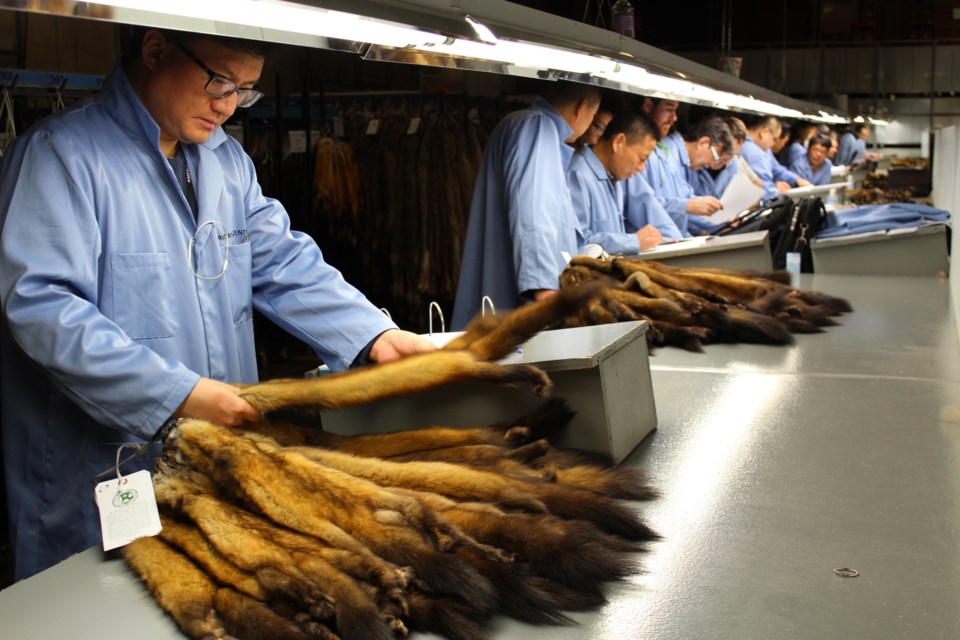Fur prices are up, and that's good news for area trappers.
Fur Harvesters Auction is located in North Bay, and is the source of some of the finest wild fur for the international fur fashion industry. Fur brokers, wholesalers and manufacturers come to this city for the extraordinary selection of wild fur available only in North Bay. Sales at the two-day auctions here reach about seven million dollars each.
So it's good for the local economy that Canadian trappers are receiving the strongest prices in years for their pelts at the auction held at the end of January in North Bay.
"We've seen a rise over last year," CEO Mark Downey told BayToday. "We came off a high in 2013 which was the industry's all-time high, but with problems with Russia and Crimea, the Asian stock market prices have been going down but we're seeing a resurgence of interest and prices."
North Bay held the first wild fur auction this year.
"We had buyers from all over...from Russia, from China and Korea. Anything to do with trim like coyotes, wolf, wolverine and fox for coats are really seeing a big increase. Canadian sable is seeing a very strong price. What's really important is clearance and we had 100 per cent clearance."
Russia is the biggest taker of north American wild fur on most species like raccoon, sable...all the fancy luxury ones. China buys a lot but they manufacture the coats and the Russian retail stores buy them to stock their shelves and sell the coats to Russians.
"So when Russia invaded Crimea it started the ball rolling with sanctions and the ruble fell even though Russian coat sales have been very, very strong the past few years they sell their coats in rubles. There getting the same amount of rubles they did years ago but when they take their currency outside, say to Hong Kong to buy more stock and trade their money to euros of Hong Kong money they have no buying power. Now their currency is strengthening and things are starting to turn around as far as the economy and political situation in Russia and China as well so that's really stirred the market up, starting with our sale in January."
There are at least a few hundred people making a living as trappers in this area says Downey.
The next sale for the Fur Harvesters is in March, but they'll be holding it in Helsinki Finland.
"The goods are starting to leave this Wednesday," explains Downey."We make three plane trips across the pond. This is our fourth year."
“More than 32,000 coyote pelts were offered at the North American Fur Auction sale, this week in Toronto and they were 100% sold at rising prices,” said Alan Herscovici, senior researcher at www.TruthAboutFur.com, a website about the North American fur trade.
Coyotes fur is being used to trim down-filled parkas and coats, an increasingly popular trend that drove strong competition among international buyers in the auction room, resulting in 100% turn-over and an average price of over $107 for the heavy western coyotes favored by the trimming trade.
Fur-trimmed coats are now the rage among young people around the world,” says a news release from the group.
“Coyote fur around a parka hood provides unequalled protection for your face against wind and cold,” said Herscovici.
“Trappers are pleased that sustainably-produced natural fur is being worn by so many young people. The fur trade is extremely well regulated in Canada and coyotes are highly abundant. In fact, coyotes have become a major predation problem for ranchers in many regions, killing lambs and calves. Some provinces and states had to issue bounties to control coyote populations when fur prices were low. But if we have to control coyotes populations, it is more ethical to use them.
“Fur is naturally warm, long-lasting and ultimately biodegradable. I simply do not agree with those who claim we’d be better off using synthetics that are generally made with petroleum, a non-renewable resource. When you buy fur you are supporting both the environment and the people who live close to the land, in rural and remote communities,” said Herscovici.



